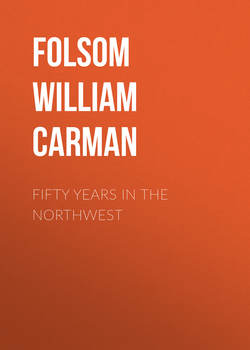Читать книгу Fifty Years In The Northwest - Folsom William Henry Carman - Страница 15
CHAPTER II.
STILLWATER AND ST. CROIX COUNTY
ST. CROIX COUNTY
ОглавлениеFrom 1819 to 1836 this valley was under the jurisdiction of Crawford county, Michigan, there being no white inhabitants save Indian traders. There was no law dispensed in this region, excepting the law that might makes right. In 1836 the territory of Wisconsin, comprising all of Michigan west of the great lakes; also all that portion of Missouri Territory out of which was formed the state of Iowa, which was organized as a territory in 1838, and admitted as a state in 1846; also that portion of Minnesota which lies west of the present state – yet unorganized – known as Dakota, was organized.
The year 1837 forms a new era in our history. Gov. Henry Dodge, of Wisconsin, on the part of the national government, was appointed to negotiate with the Ojibways. They met at Fort Snelling. A treaty was made, the Indians ceding to the United States all their lands east of the Mississippi, to near the headwaters of the St. Croix and Chippewa rivers.
A deputation of Dakotas at Washington, the same year, ceded all their lands east of the Mississippi to the parent government, thus opening to settlement all this portion of Minnesota and Wisconsin. But few adventurers made their way into this far off region, however, for many years. A steamer once in two months was the only mode of travel, excepting by birch canoe.
In October, 1837, at Prairie du Chien, I met a party who had ascended the Mississippi and the St. Croix as far as St. Croix Falls. According to their account they had found the place where creation ended, where a large river, capable of bearing a steamer, burst out of a rock like that which Moses smote. They had seen "the elephant with his quills erect," and were returning satisfied to their New England home. They had entered the since famous Dalles of the St. Croix, located at the head of navigation on that river.
In the year 1838, being the year succeeding the purchase of the lands bordering on the St. Croix river and a portion of her tributaries, may be dated the commencement of the settlement of the St. Croix valley; but with the exception of the Hon. Joseph R. Brown, the parties that I shall enumerate as opening business, came here for the purpose of lumbering, and in no instance as permanent settlers. The valley was considered too far north and the soil too sterile for cultivation, but many of those who came here in 1838 found out their mistake and made choice of the valley for their permanent homes. They were afterward abundantly satisfied with the healthfulness of the climate and the fertility of the soil. Several companies were formed this year for the ostensible purpose of lumbering, many members of which became permanent settlers.
The first dismemberment of the St. Croix valley from Crawford county was by the organization of the county of St. Croix. Joseph R. Brown was elected representative to the legislature, from the north part of Crawford county. His residence at that time was Gray Cloud, now in Washington county. Mr. Brown introduced the bill for the organization of St. Croix county, which passed and was approved by the governor of Wisconsin, Jan. 9, 1840. The writer of these sketches was employed by Messrs. Brown and Brunson (the representatives from this district), in December, 1839, to take them with a team from Prairie du Chien to Madison. One of the indispensable requirements for traveling in those days was a large "Black Betty," which was the butt of much wit and humor. Mr. Brown said the contents of Old Betty must establish a new county away up in the Northwest. The deed was done – the act did pass. I don't know whether Old Betty came back to assist in organizing the county or not. It is well to say Mr. Brown acquitted himself with honor to his constituents, and was successful in the one great object for which he sought the election. This was the precursor to coming events – a shadow cast before. For it was under this organization that Northwest Wisconsin and Minnesota first obeyed the mandates of law and order.
Under the provision of the act of organization, Hazen Mooers, of Gray Cloud, Samuel Burkelo, of Marine, and Joseph R. Brown, of Dakotah, were constituted a board of county commissioners with county seat located at Dakotah.
This town was located at the head of Lake St. Croix, on the west side, on unsurveyed government lands, known as "Joe Brown's Claim." When the Wisconsin legislature of 1840 made this the county seat of St. Croix county it was named Dakotah.
